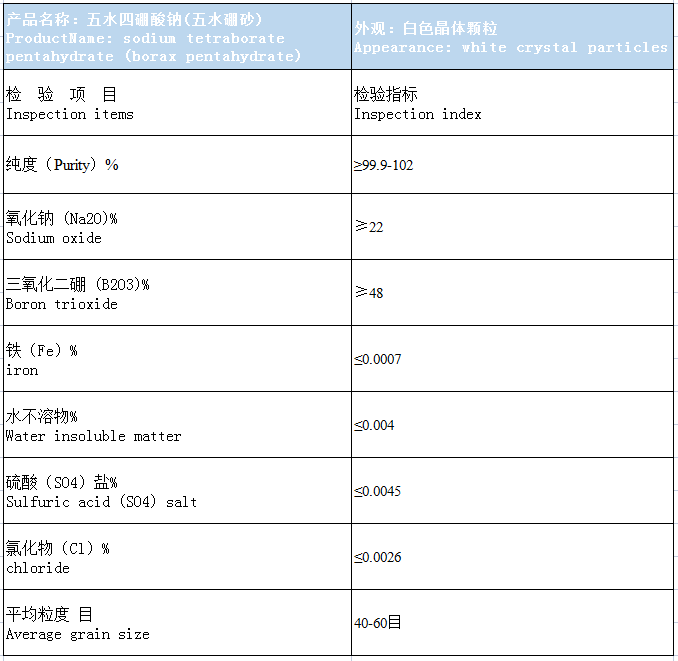Welcome to Henan Sinocean Chemical Co.,Ltd.
Product description
Chinese name: Borax pentahydrate
Also known as: sodium tetraborate pentahydrate
Chemical formula: Na2B407 5H2O
Form: white crystalline powder
CAS Number: 12179-04-3
Molecular weight 291.29
Packing: 25KG/bag, inner plastic and outer weaving
Physical and chemical properties
White crystal powder. Density 1.815g/cm3. Melting point 75 ℃. Soluble in hot water and glycerol, slightly soluble in ethanol and carbon tetrachloride. The aqueous solution is alkaline. When heated to 120 ° C, the crystal water is completely lost. It is stable in dry air, but slowly absorbs moisture in the air under humid conditions and becomes borax decahydrate. With sterilization, disinfection, flux and high temperature adhesion properties.
Production method
It is prepared from sodium tetraborate decahydrate solution, controlling the feeding temperature to be higher than 70°C and the crystallization temperature to be higher than 60°C for recrystallization, filtering and drying at below 120°C.
It can also be prepared by dissolving natural boron ore with hot water, filtering and separating, cooling and crystallizing and controlling the crystallization temperature to be higher than 60 °C, and washing with a mother liquor with a concentration of 25%.
For the manufacture of special glass. Used as antifreeze and anticoagulant in mining and metallurgy. It is also used as an additive for electroplating solutions, a cosolvent for non-ferrous metals and special alloys.
Technical parameter

Product Usage
Used as herbicide and soil fungicide. In the glass industry, it is used to manufacture optical glass and heat-resistant and corrosion-resistant glass. Used as a glaze in the enamel industry and applied to metal surfaces, it is strong and durable. Used as antifreeze and anticoagulant in mining industry and metallurgical industry. In the non-ferrous metal industry, it is used as electrolyte additive and non-ferrous metal fusion agent. It is used to make glazes in the ceramic industry with good results. Used as a water softener in cosmetics. It is used in the manufacture of anti-corrosion and anti-rust inhibitors and other boron compounds.
Mainly used in the glass and enamel industry. In glass, it can enhance the transmittance of ultraviolet rays, improve the transparency and heat resistance of glass. In enamel products, the enamel is not easy to fall off to make it shiny. In special optical glass, glass fiber, non-ferrous metal solder, jewelry binder, printing and dyeing, washing (silk and wool, etc.), gold refining, cosmetics, pesticides, fertilizers, borax soap, preservatives, antifreeze and medicine Disinfectants are also widely used.
Borax is the basic raw material for the preparation of boron-containing compounds, and almost all boron-containing compounds can be obtained from borax. They have important and extensive uses in metallurgy, steel, machinery, military, knives, paper, electronic tubes, chemicals and textiles.
In medicine, borax is used for disinfection and antiseptic treatment of skin and mucous membranes, skeletal fluorosis, tinea pedis, pulpitis, fungal vaginitis, cervical erosion, bedsores, acne, external auditory canal eczema, herpes virus skin diseases, and epilepsy treatment. in the treatment of tumors. In animal medicine, borax is used for the treatment of chicken laryngotracheitis, goat infectious impetigo, mycoplasma swine pneumonia, and bovine chronic mucinous endometritis. It has also attracted much attention as a feed additive.
It is used as herbicide, and it is used in non-cultivation area for killing weeding. Except using it alone, it can be mixed with sodium chlorate to reduce the flammability of sodium chlorate.
In industry, borax is the most important industrial boron mineral. Borax is the most important compound of boron. Boron is often listed as a rare element in foreign countries, but there are abundant borax mines in my country. Therefore, boron is not a rare element in our country, but a high-yield element. In industry, borax is also used as a solid lubricant for metal drawing and so on. It is often used as a (non-active) flux to purify metal surfaces in the welding and maintenance of refrigeration equipment such as refrigerators, freezers, and air conditioners.
Next product: Boric Acid